3rd USA auction
Bidding on 1172 lots has ended on 19th March 2023. 75% of all lots sold
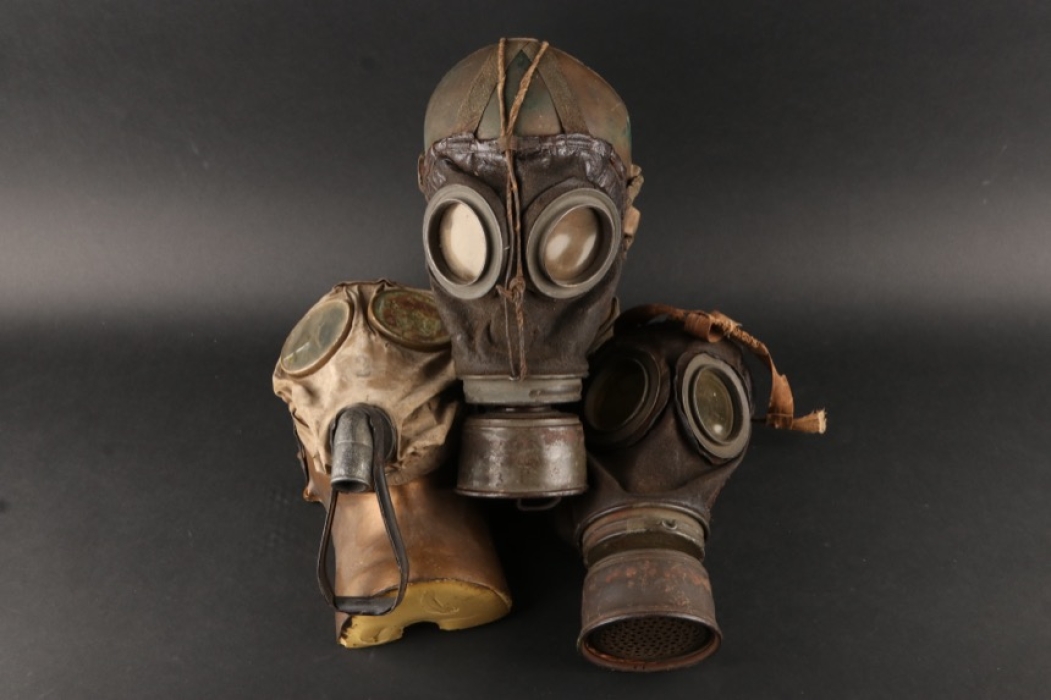
2x M1917 & 1x M1915 gas masks
GBP 0,00
Own a similar product you want to sell? We are here for you at +49 8541 9053699
-
PAYMENT
-
HOW CAN I PAY FOR MY ORDER?
AUCTIONSYou will receive an e-mail confirming your successful bids the day after the auction has ended. In your personal my ratisbon's you will be able to inform us about your most convenient payment method for this order or tell us about an alternative shipping address.
If we don’t hear from you within 24 hours, we will send an invoice choosing the payment and shipping options which we think are the most comfortable ones to you. If you decide to change your shipping or payment method after receiving your invoice, just drop us a line or visit my ratisbon's/ORDERS for any more details.
SHOP ORDERSChoose your payment method when ordering and submit your order. Once your order has been received we will send an invoice including your shipping costs and your payment instructions.
After receiving the invoice, the order must be paid within 7 days.
Please contact us to discuss layaway options.To learn more about paying at ratisbon's, please see your FAQ pages.
WE ACCEPT FOLLOWING PAYMENT METHODS
-
-
Versand
-
HOW DO YOU SHIP MY NEW TREASURES?
PACKING & TRACKINGWe usually send out orders within 1-3 working days after your payment has been received. In most cases, we are faster than this! We will inform you when your goods are being dispatched and provide a tracking number, In addition, you can always check your order status at my ratisbon's/ORDERS. Delivery times will vary depending upon the delivery destination and type of shipping service you have chosen.
SHIPPING TO ALTERNATIVE ADDRESSIf you prefer to have your order shipped to your work address or a friend during your absence, we will happy to arrange this for you. Send us an email letting us know about your new shipping address and we will be happy to send an updated invoice to you.
OUR LOGISTIC PARTNERS ARE AS FOLLOWS
-
-
OUR GUARANTEE
-
 OUR GUARANTEE!
OUR GUARANTEE!We only offer collectables which to the best of our specialists knowledge are authentic. About 15% of all consignments are returned to the consignor after extensive research due to authenticity issues.
Unlike traditional auction houses we do offer a full right of return. If you are not satisfied with what you won or bought, you may return it within 14 days. Please inform us and we will instruct you on how to return the goods. For more information, please visit FAQ pages.
Important note: Cancelling bids after an auction may disappoint the consignor, who like you is a collector. This situation is easy to avoid. We encourage you not to bid on any collectable if you are unsure if it fits into your collection. Ask us to cancel your bid 24 hours prior to the end of an auction to avoid this situation.
-
COUNTRY Imperial Germany
DIMENSIONS
WEIGHT
 US LOT US3-0033
US LOT US3-0033EAN 3000000021293
 US LOT US3-0033
US LOT US3-0033PERIOD until 1918
COUNTRY Imperial Germany
MATERIAL
DIMENSIONS
MAKER
WEIGHT
COUNTRY Imperial Germany
 US LOT US3-0033
US LOT US3-0033DIMENSIONS
EAN 3000000021293
MAKER
WEIGHT
2x M1917 & 1x M1915 gas masks
Description
Here a lot of 3 gas masks: 2x M1917 & 1x M1915. Still in good condition.
A rare set.
Condition
2-
Seller
History Trader Inc., 521 Thorn Street #165, Sewickly, PA 15143-0165, USA
OBJECT NAME
Ledermaske (or Gasmaske M1917)
NATION
German Empire
DATE OF INTRODUCTION
June 6th 1917 (KM, Allg.Kriegs.Dep.n.2852/ 5.17, 6.6.1917)
FEATURES
Made of oiled sheepskin to prevent gas absorption, the Ledermaske (leather gas mask) was an evolution of the earlier Rahmenmaske (frame gas mask) made of rubberised fabric. The Ledermaske had specific improved lenses (Klarscheiben) made of a special synthetic material that could absorb moisture and prevent fogging. The mask was equipped with fabric-covered elastic straps (called Spiralbänder) already in use with the earlier Rahmenmasken. A front cord was added to support the filter attachment disc (Mundring) and thus the weight of the filter itself.
FILTERS
Ledermasken were fitted with three layer filters (Dreischichteneinsatz) types 11-C-11 and from summer 1918 the two layers (Zweischichteneinsatz) 11-C-11 filters.
MANUFACTURERS
According to the War Ministry circular from April 1918 (KM, Chem.Abt.n.890/ 2.18, 16.4.1918), the manufacturers were Auergesellschaft, Berlin; Hanseatische Apparatebaugesellschaft, Kiel; Drägerwerk, Lübeck; Metzler u. Co, München; J. Roekl, München.
CARRYING CANS
A specific carrying box was introduced on 6 June 1917, with the same War Ministry circular that announced the introduction of the Ledermaske. In addition to this official type, known among collectors as the Bereitschaftbüchse type 1917, a wide variety of transport cans were used, mainly recycling older Gummimasken ones: these were modified using the same body but applying a higher closing lid. Finally, for a short period, wooden transport containers were also produced.
WEARING METHOD
Every soldier and officer at the front had to carry his gas mask with him. The carrying can was usually hung from the neck and put on the breast or on the side. When the gas alarm was given, he must quickly open the can, extract the gas mask and fit it to the wearer’s head. Filters could be easily changed by unscrewing the first and screwing on the new one. After use, the mask had to be cleaned, checked if damaged or not, and put completely dry inside the carrying can.


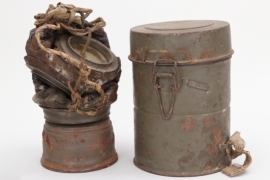
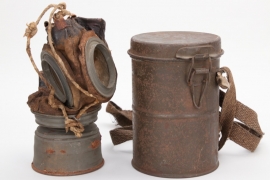
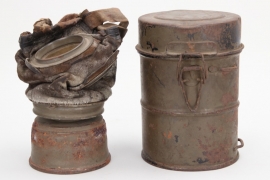
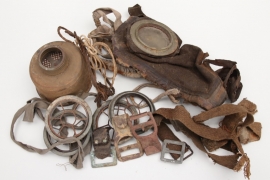
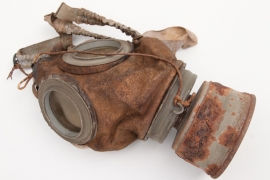
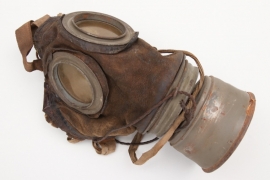
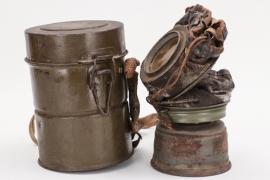
.jpg)